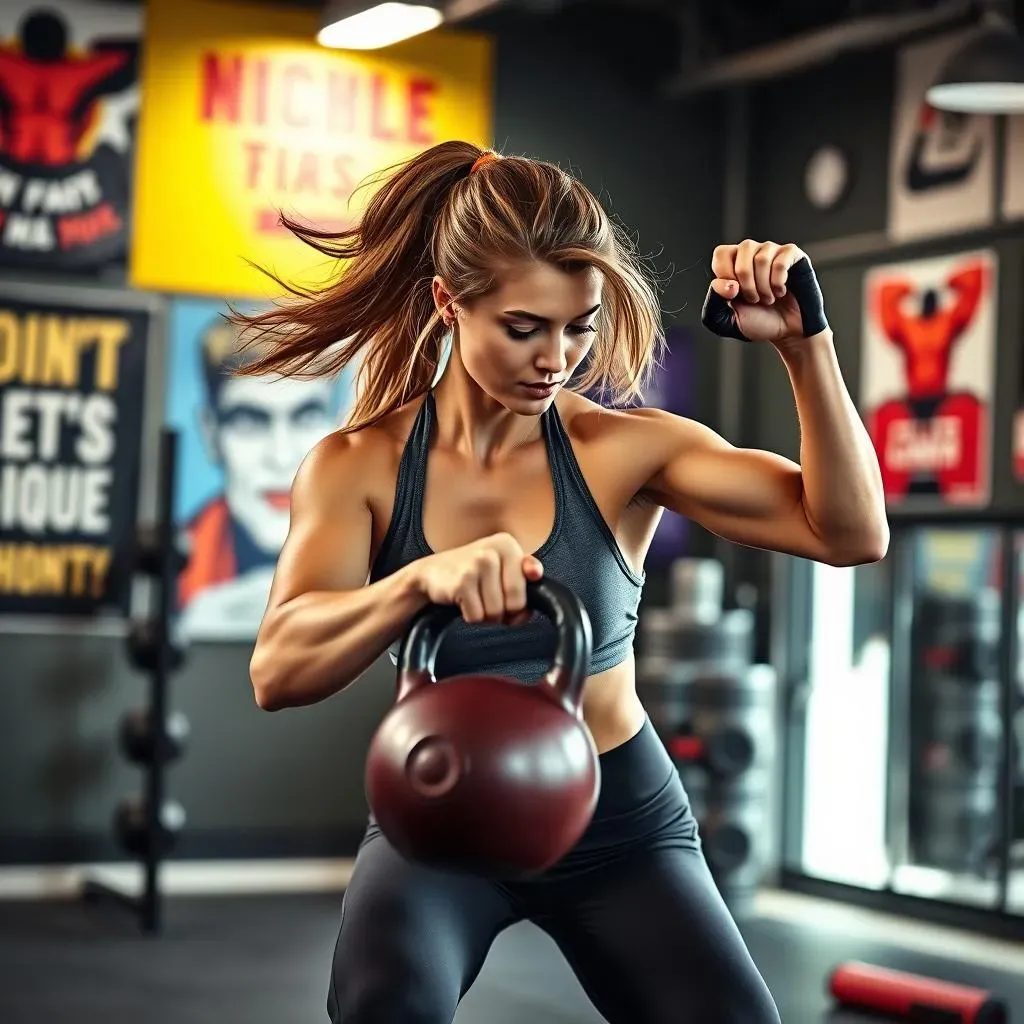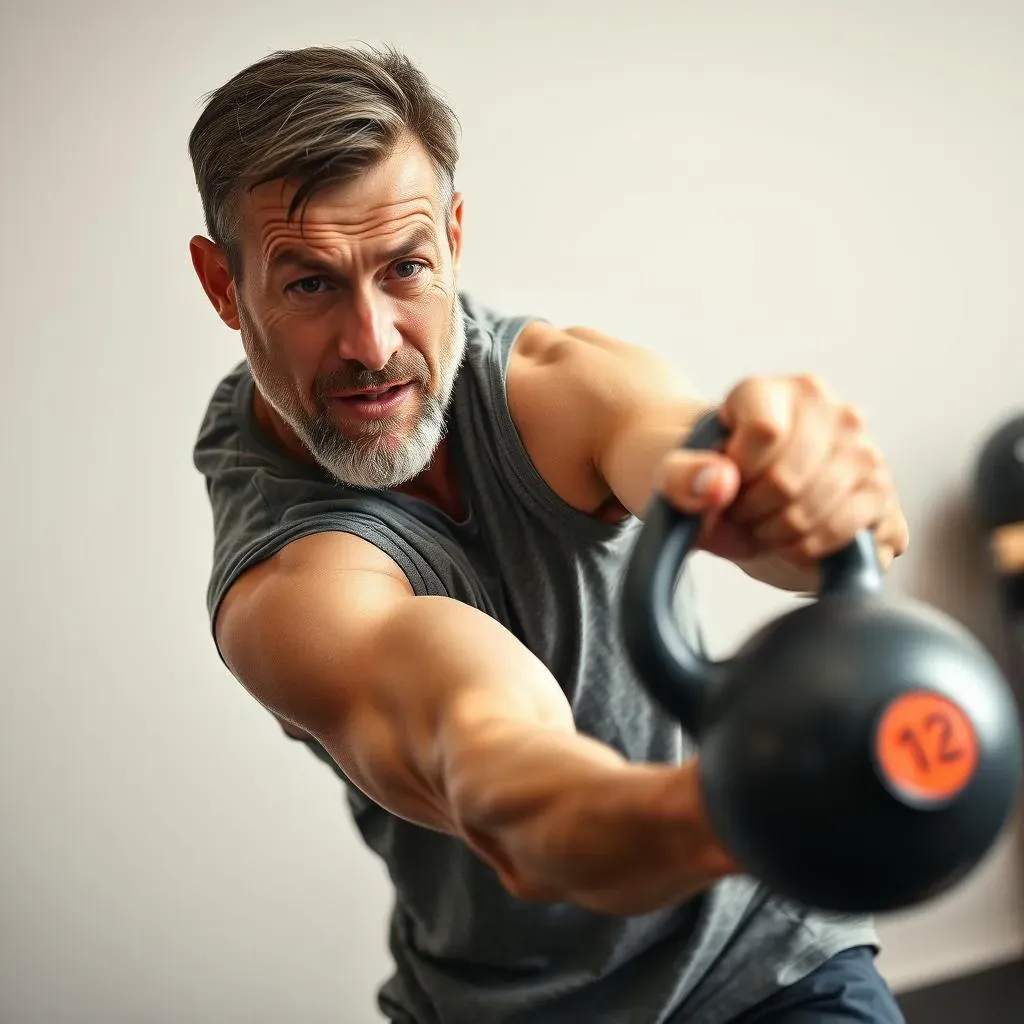Table of Contents
Ever wondered if that lonely kettlebell in your garage could be your ticket to a full-body transformation? The answer, my friend, is a resounding yes! Forget those fancy gym machines; a single kettlebell is a powerhouse tool for building strength, torching calories, and improving your overall fitness. This article will show you how a few simple moves can work your entire body, from your toes to your shoulders. We're not just talking about some light exercise either; this is about real, functional strength. We'll explore the best exercises to get you started, discuss the perks (and a few risks) of kettlebell training, and give you crucial safety tips. So, if you're asking, "can you do a full body workout with a kettlebell?" prepare to be amazed by what you can achieve with this simple, yet powerful piece of equipment. Let's get swinging!
Getting Started With Your Kettlebell

Getting Started With Your Kettlebell
Choosing Your First Kettlebell
Okay, so you're ready to start swinging, but hold up! Before you grab the first kettlebell you see, let's talk weight. It's not about ego lifting here; it's about starting smart. For most beginners, a 10-15 pound kettlebell is a good starting point. I know it might sound light, but trust me, when you're doing swings and squats, it'll feel like plenty. The goal is to learn the movements correctly. You can always go heavier later, but poor form will get you nowhere, except maybe injured. It's like learning to ride a bike, you don't start on a unicycle, right?
Think about it this way, you're building a foundation, not a skyscraper. Don't worry about what the person next to you is lifting. Focus on feeling the muscles working and getting comfortable with the movement. If you are unsure, a good test is to try a few goblet squats with the weight, if you can do 10-12 reps with good form, you're probably in the right ballpark. And remember, you can always adjust. Starting with a lighter weight is like learning to draw with a pencil before painting a masterpiece, you need to get the basics down first.
Your First Kettlebell Workout
Now, let's get to the fun part—your first workout! Don't jump into some crazy, complicated routine you saw online. Start with the basics: goblet squats, deadlifts, and swings. These three moves alone will work a ton of muscles. Aim for 2-3 sets of 8-10 reps for each exercise. It is best to do the moves slowly at the start, don't try to rush it. This is about learning the movement, not about breaking any records.
Remember to keep your core engaged during each exercise. This is the secret sauce. It's like having a built-in weightlifting belt. And don't forget to breathe! It sounds simple, but holding your breath is a common mistake. Inhale on the way down, exhale on the way up. Think of your breath as the rhythm for your body. Proper form trumps everything else. And if you are unsure, there are a lot of good videos online to help you.
Exercise | Sets | Reps |
|---|---|---|
Goblet Squat | 2-3 | 8-10 |
Kettlebell Deadlift | 2-3 | 8-10 |
Kettlebell Swing | 2-3 | 8-10 |
The 6Move FullBody Kettlebell Workout

The 6Move FullBody Kettlebell Workout
Goblet Squat to Overhead Press
Alright, let's kick things up a notch with the goblet squat to overhead press. This move is like a two-for-one deal – you're hitting your legs and shoulders at the same time. Start by holding the kettlebell close to your chest, like you're hugging it. Squat down, keeping your back straight, then as you stand up, press the kettlebell straight above your head. It is important to do a smooth motion, no jerky movements. This isn't a race; it's about control and strength.
Think of it as a dance, a smooth flow from the squat to the press. You should feel your quads working in the squat and your shoulders and core activating as you press the weight up. If you are feeling that you can't press the weight up, then it is a good idea to reduce the weight you are using. Remember, it is not about how much weight you are lifting, but how you are lifting it. Proper form is essential to get the most out of the exercise and prevent injuries.
Bent-Over One-Arm Kettlebell Row
Next up, the bent-over one-arm kettlebell row. This move is fantastic for your back and biceps. Stand with your feet shoulder-width apart, hinge at your hips, and let the kettlebell hang down. Keep your back straight, and pull the kettlebell up towards your chest, squeezing your shoulder blade as you go. It's like you are trying to start a lawnmower, but instead of pulling the cord, you're pulling a weight.
The key here is to keep your core tight and avoid twisting your body. Imagine you have a glass of water on your lower back, you don't want to spill it. Focus on pulling with your back muscles, not just your arm. Do all the reps on one side, then switch. This exercise will build a strong back and will help improve your posture. It is important to maintain a neutral spine, that means you should not arch your back too much, or bend over too much.
"The kettlebell is a tool, not a magic wand. It's your consistency and effort that brings the results." - Some wise person.
Kettlebell Swing
Now we are talking! The kettlebell swing is a power move, and it works your whole posterior chain—your glutes, hamstrings, and back. Start with the kettlebell on the floor in front of you. Hinge at your hips, swing the kettlebell back between your legs, and then explosively drive your hips forward, swinging the kettlebell up to chest height. This is a hip hinge, not a squat, so you are not bending your knees that much.
The swing is all about momentum, not just lifting the weight with your arms. Think of it like a pendulum; your hips are the engine. It's important to keep your core engaged throughout the movement. This is what gives you the power and the control. If you are doing it right, you should feel it in your glutes and hamstrings. This move will not only build strength, but it will also improve your cardiovascular fitness.
Exercise | Muscle Group |
|---|---|
Goblet Squat to Overhead Press | Legs, Shoulders, Core |
Bent-Over One-Arm Kettlebell Row | Back, Biceps |
Kettlebell Swing | Glutes, Hamstrings, Back |
Bridge with Single-Arm Chest Press
Let's hit the floor with the bridge with single-arm chest press. Lie on your back with your knees bent and feet flat on the floor. Hold the kettlebell in one hand, then lift your hips up into a bridge position. While holding the bridge, press the kettlebell straight up towards the ceiling. This exercise works your chest, glutes, and core, and it will challenge your stability.
Make sure you keep your core engaged and your hips level during the press. It is important to control the weight, don't let it wobble around. Do all the reps on one side, then switch. It's like a mini-workout for your entire body. This exercise will not only build strength, but it will also improve your balance and coordination. It is important to maintain proper form throughout the exercise to avoid any injuries.
Single-Arm Kettlebell Clean
Now, let's get a little technical with the single-arm kettlebell clean. This move takes a bit of practice, but it's worth it. Start with the kettlebell on the floor in front of you. Hinge at your hips, swing the kettlebell back, then pull it up and around, catching it in a rack position at your shoulder. This is a full-body exercise that requires coordination and power. It's like you are trying to make the kettlebell float up to your shoulder.
The key is to use your hips and legs to generate power. It is not just your arms that are doing the lifting. The move should feel smooth and controlled, not jerky or forced. Do all the reps on one side, then switch. This exercise will not only build strength, but it will also improve your athleticism and coordination. It is important to practice the movement slowly at the start. You can always increase the speed and weight as you get more comfortable with the movement.
Kettlebell Deadlift
Finally, let's finish with the kettlebell deadlift. This is a classic exercise for building overall strength. Stand with your feet shoulder-width apart, hinge at your hips, and grab the kettlebell. Keep your back straight, and lift the kettlebell up by engaging your glutes and hamstrings. It's like you are picking up a heavy box, but with a kettlebell.
The focus here is on using your legs and glutes to lift the weight, not just your lower back. Keep your core tight and avoid rounding your back. Lower the kettlebell back to the floor in a controlled manner. This exercise is great for building strength in your legs, back, and core. It is important to maintain proper form to avoid any injuries. And remember, you can always start with a lighter weight, and increase it as you get stronger.
Benefits and Risks of Kettlebell Training

Benefits and Risks of Kettlebell Training
Okay, let's talk turkey – or should I say, kettlebell? On one hand, these things are amazing. You can build strength, improve your heart health, and even get better balance, all with one piece of equipment. It's like having a portable gym that fits in a corner. Kettlebell training can also help you build muscle, especially if you are older. It can also improve your grip strength. For older folks, that's a big deal, it can help you with everyday stuff. Plus, you can do it at home, no need for expensive gym memberships. It is like having your own personal trainer at home.
But, it's not all sunshine and rainbows, right? There are some risks. If you are not careful, you could end up with bruises, muscle strains, or even worse. I know someone that tried to lift too heavy, and he ended up with a back injury that took months to heal. For older adults, people with osteoporosis or heart problems, and pregnant women, kettlebells can be risky. There is also a risk of pelvic organ prolapse, which is definitely not something anyone wants to deal with. This is why it is important to start slow, and do not rush into it, and always talk to your doctor before you start any exercise program. It is like learning a new skill, you need to be aware of the risks.
Benefit | Risk |
|---|---|
Improved Strength | Bruising |
Better Balance | Muscle Strains |
Enhanced Heart Health | Pelvic Organ Prolapse |
Increased Muscle Mass | Injuries if not done correctly |
Improved Grip Strength | Not suitable for everyone |
Safety Tips for Kettlebell Workouts

Safety Tips for Kettlebell Workouts
Warm-Up and Cool-Down
Alright, before you start slinging that kettlebell around like a wild west gunslinger, let's talk about warming up. Think of your body like a car engine; you wouldn't start it at full speed on a cold morning, right? Same goes for your muscles. A good warm-up gets the blood flowing and prepares your body for the workout ahead. I like to start with some light cardio, like jumping jacks or high knees, followed by some dynamic stretches, like arm circles and leg swings. It is like telling your body "Hey, we are about to do something fun".
And don't forget about the cool-down! It's not just an afterthought; it's a crucial part of your workout. After you've finished your reps, do some static stretches, holding each stretch for about 30 seconds. This helps your muscles recover and reduces the risk of soreness. It is like putting your car in park after a long drive. It might feel like you are done, but taking 5 more minutes to cool down can make a big difference in how you feel the next day. Skipping the cool down is like forgetting to put the parking brake on, it is not a good idea.
Proper Form and Technique
Now, let's get down to the nitty-gritty: form. This is where many people go wrong. It is not about how much weight you can lift, it is about how well you can lift it. Proper form is your best friend when it comes to kettlebell training. Bad form is like a house built on sand, it is not going to last long. If you are not sure about your form, check out some videos online or even better, get a qualified trainer to show you the ropes. It's an investment that will pay off in the long run.
Pay attention to your body, and if something does not feel right, stop. It is not worth pushing through the pain. It is like ignoring the warning lights on your car's dashboard, you are asking for trouble. Start with lighter weights, and focus on getting the movements right. As you get more comfortable, you can increase the weight and the intensity. Remember, it is a journey, not a race. Every single rep you do with proper form is a step in the right direction. It might feel slow at the start, but it is the best way to get the results you want.
"Your body is your temple, treat it with respect, especially during kettlebell workouts." - Some wise person.
Safety Tip | Why It Matters |
|---|---|
Warm-Up | Prepares muscles, prevents injury |
Cool-Down | Reduces soreness, aids recovery |
Proper Form | Maximizes results, minimizes injury |
Listen to Your Body | Avoids overexertion, prevents injuries |